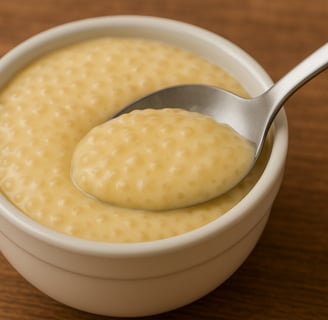Tapioca Pudding: Gluten-Free Energy & Benefits
Discover the light and gluten-free energy of tapioca pudding, exploring its Amazonian origins and nutritional benefits that rival Mediterranean cuisine, perfect for modern healthy eating.
HEALTHY DISHES
CILZA DUARTE
5/31/20256 min read


Tapioca Pudding: Light and Gluten-Free Energy in Every Serving
My grandmother used to say that the bubbles in tapioca pudding were tiny pockets of joy waiting to burst on your tongue. As a child, I'd watch those translucent pearls transform from hard pellets into pillowy gems, swimming in a sea of sweet vanilla-scented cream. Only years later would I understand that what I thought was simply dessert magic was actually a perfect example of food science at work—and an ancient culinary wisdom that predates most modern dietary trends.
Have you ever noticed how some foods feel simultaneously indulgent yet somehow... virtuous? That's the curious paradox of tapioca pudding.
When Amazonian Tradition Meets Modern Nutrition
The unassuming cassava root—or "mandioca" as we call it where I grew up near the Brazilian rainforest—doesn't look like much. Knobby, brown, and rather unremarkable. Yet this humble tuber has sustained communities across South America for millennia, with indigenous peoples developing sophisticated processing techniques to transform it from potentially toxic in its raw state to life-sustaining in various forms.
Tapioca—those pearly spheres of starch extracted from cassava—embodies this ancient innovation.
What fascinates me most is how this traditional Amazonian staple aligns perfectly with modern dietary needs. Gluten-free before "gluten-free" became a household term. Low in fat before low-fat diets were fashionable. A clean energy source before "clean eating" became a hashtag.
In fact, the parallels between traditional Amazonian food wisdom and contemporary nutritional science are striking. Much like the acclaimed Mediterranean diet—with its emphasis on simple, whole ingredients—Amazonian culinary traditions offer valuable lessons in sustainable nutrition that we're only beginning to fully appreciate.
But here's where things get interesting.
The Pearl Paradox: Simple Yet Sophisticated
I confess that I've always found the texture of tapioca pudding somewhat beguiling. The way those small pearls pop gently between your teeth—simultaneously firm and yielding—creates an eating experience unlike any other dessert. It's what food scientists call "complex mouthfeel," but what my grandmother would simply describe as "gostoso" (delicious in Portuguese).
Tapioca pudding exists in this curious culinary limbo:
Too humble to be considered gourmet
Too distinctive to be ordinary
Too nutritious to be dismissed as mere comfort food
(And honestly, isn't that the sweet spot we're all seeking in our food choices these days?)
The process of making tapioca pudding itself reflects this beautiful contradiction. The preparation is deceptively simple, yet requires an attentiveness that's becoming increasingly rare in our hurried food culture. Those pearls demand your patience—rush them and they'll remain hard in the center; neglect them and they'll dissolve into an unappetizing mush.
In a world of instant gratification, tapioca teaches us to slow down. To pay attention. To respect the process.
Wait... am I still talking about pudding, or have I wandered into life philosophy territory? (Perhaps the best foods always do this to us.)
Mediterranean Meets Amazonian: Unexpected Culinary Cousins
At first glance, the sun-drenched Mediterranean basin and the humid Amazon rainforest couldn't seem more different. Yet their traditional food systems share remarkable commonalities—ones that modern nutritional science is only now catching up to.
Both culinary traditions emphasize:
Fresh, minimally processed ingredients that maintain their nutritional integrity. The Mediterranean has its olive oil; the Amazon has nutrient-dense roots like cassava.
Sustainable sourcing that works in harmony with local ecosystems rather than depleting them. The Mediterranean fisherman takes only what he needs; the Amazonian harvester ensures the forest regenerates.
Balanced energy release through complex carbohydrates. Mediterranean whole grains and Amazonian starches like tapioca both provide steady, sustained energy rather than blood sugar spikes.
Adaptability across various dietary needs. Both traditions offer naturally accommodating options for various modern dietary restrictions—like tapioca's inherent gluten-free quality.
"Tá bom demais!" as we say in the Amazon—"It's too good!" when something exceeds all expectations. This cross-cultural nutritional harmony certainly qualifies.
The Science Behind the Pearls
Now, I'm not typically one to geek out on food chemistry (actually, that's not entirely true—I absolutely do), but understanding what makes tapioca special helps explain its enduring appeal and growing popularity.
Tapioca consists almost entirely of carbohydrates in the form of starch—specifically amylose and amylopectin. When heated in liquid, these starch molecules absorb water and swell, creating that characteristic gelatinous texture. The process, called gelatinization, is what transforms those hard little pellets into the pleasingly chewy pearls we love.
But here's where tapioca distinguishes itself nutritionally:
Unlike many other starchy foods, tapioca contains virtually no protein or gluten, making it an ideal energy source for those with various food sensitivities or allergies. Its simplicity is precisely what makes it so versatile.
The starch in tapioca digests easily, providing quick energy without taxing the digestive system—something athletes and those with sensitive stomachs equally appreciate.
Na verdade, pensando bem... tapioca's unique properties explain why it appears in so many forms across cultures: as a thickening agent in soups and sauces, as chewy bubbles in boba tea, as a crispy wrapper in Vietnamese bánh tráng, and of course, as our beloved pudding.
Beyond Dessert: Tapioca as Nutritional Powerhouse
Let's challenge our assumptions for a moment. What if we stopped categorizing tapioca pudding as merely a dessert and recognized it as what it actually is: a nutritionally significant food with genuine health benefits?
Consider this: When prepared thoughtfully, tapioca pudding can be:
A clean, easily digestible energy source—ideal for athletes, children, and anyone needing sustained energy without digestive distress.
An excellent delivery vehicle for other nutritious ingredients—think fresh fruits, nuts, spices with anti-inflammatory properties, or protein-rich seeds.
A naturally gluten-free option that doesn't rely on highly processed alternative flours or additives—simplicity at its finest.
A prebiotic food that can support gut health—those resistant starches feeding beneficial bacteria in our microbiome.
I've watched with amusement as various "superfood puddings" have cycled through wellness trends over the years—chia, avocado, various grain-based concoctions—all while tapioca pudding has quietly existed for centuries, offering many of the same benefits without the trendiness or price tag.
As my Amazonian grandmother would say with a knowing smile: "O barato sai caro"—what seems cheap often ends up expensive. The humble solutions are often the most enduring.
The Modern Tapioca Renaissance
Something interesting has been happening in progressive kitchens and health-conscious homes lately. Tapioca is experiencing a quiet renaissance—moving beyond the realm of nostalgic comfort food into something rather sophisticated.
Innovative chefs are:
Infusing tapioca with unexpected flavors like lemongrass, cardamom, or even coffee
Using it as a canvas for seasonal fruit compotes and artisanal honey
Exploring savory variations with herbs, spices, and even fermented elements
Appreciating its textural contribution to modern plant-based cooking
Meanwhile, nutritionists and functional medicine practitioners are recognizing tapioca's value in therapeutic diets—from FODMAP protocols to elimination diets to recovery nutrition.
I recently spoke with Maria Gonzalez, a nutritionist specializing in digestive health, who shared: "We're rediscovering what traditional cultures have known for generations. Sometimes the foods that seem simplest offer the most elegant solutions to complex dietary challenges."
This renewed appreciation reminds me of how Mediterranean ingredients like olive oil and legumes experienced their own renaissance when their health benefits became more widely understood. Traditional wisdom, validated by modern science, creates a powerful combination.
Making Tapioca Pudding Your Own
The beauty of tapioca pudding lies partly in its chameleon-like ability to adapt to your nutritional needs and taste preferences. It provides a neutral canvas that welcomes personalization.
Here's how you might reimagine this classic for different dietary goals:
For sustained energy: Add healthy fats like coconut cream and protein-rich toppings like hemp seeds or nut butter.
For digestive health: Incorporate anti-inflammatory spices like ginger, turmeric, or cinnamon, and perhaps a touch of raw honey (known for its prebiotic qualities).
For muscle recovery: Boost protein content with Greek yogurt instead of milk, and add antioxidant-rich berries to combat exercise-induced inflammation.
For cognitive function: Top with walnuts, blueberries, and a touch of dark chocolate—all associated with brain health.
The possibilities extend far beyond these suggestions, limited only by your imagination and nutritional needs. (And isn't that the hallmark of truly great food—the ability to evolve while maintaining its essential character?)
A Pudding with Purpose
As we've journeyed together through the world of tapioca pudding—from its Amazonian origins to its modern applications—I hope you've gained a new appreciation for this unassuming dish.
In a food landscape often dominated by extremes—either ultra-processed convenience foods or precious, Instagram-worthy creations—tapioca pudding offers something refreshingly different: nourishment without pretension, tradition without rigidity, enjoyment without guilt.
Perhaps that's the ultimate lesson here. The most valuable foods in our repertoire are often those that have quietly sustained generations without fanfare or marketing campaigns. They endure not because they're trendy, but because they work—providing what our bodies need in a form that also satisfies our souls.
The next time you enjoy a spoonful of tapioca pudding, notice those perfect little pearls—each one a tiny capsule of energy, waiting to fuel your next adventure. What seems simple is often profound, if we pay close enough attention.
And isn't that true of the best things in life?
What forgotten food wisdom might you rediscover in your own culinary heritage? I'd love to hear what traditional foods have sustained your family through generations.
Visit www.myamazonfood.com for more articles on traditional foods with modern nutritional benefits.
#GlutenFreeEnergy #AmazonianSuperfood #TraditionalWisdom #CleanEating
Inspiration - Health
Explore recipes, tips, and culinary articles today.
wellness
Flavor
cilzaduarte@gmail.com
55 81 98087-8684
© 2025. All rights reserved.
